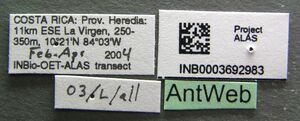Neivamyrmex rosenbergi
| Neivamyrmex rosenbergi | |
|---|---|

| |
| Scientific classification | |
| Kingdom: | Animalia |
| Phylum: | Arthropoda |
| Class: | Insecta |
| Order: | Hymenoptera |
| Family: | Formicidae |
| Subfamily: | Dorylinae |
| Genus: | Neivamyrmex |
| Species: | N. rosenbergi |
| Binomial name | |
| Neivamyrmex rosenbergi (Forel, 1911) | |
This species is only known from males and has yet to be associated with queens or workers.
Identification
Distribution
Latitudinal Distribution Pattern
Latitudinal Range: 10.61046° to 10.33333°.
| North Temperate |
North Subtropical |
Tropical | South Subtropical |
South Temperate |
- Source: AntMaps
Distribution based on Regional Taxon Lists
Neotropical Region: Colombia, Costa Rica, Ecuador (type locality), Guatemala, Panama.
Distribution based on AntMaps
Distribution based on AntWeb specimens
Check data from AntWeb
Countries Occupied
| Number of countries occupied by this species based on AntWiki Regional Taxon Lists. In general, fewer countries occupied indicates a narrower range, while more countries indicates a more widespread species. |

|
Estimated Abundance
| Relative abundance based on number of AntMaps records per species (this species within the purple bar). Fewer records (to the left) indicates a less abundant/encountered species while more records (to the right) indicates more abundant/encountered species. |

|
Biology
Jack Longino: I know this species from two males collected at the 500m site (El Ceibo) on the Barva transect of Braulio Carrillo National Park. Ronald Vargas collected one of them at a mercury vapor lamp. I collected the other one in 1985, but I have no notes on how I collected it.
Castes
Images from AntWeb
 
| |
| Syntype of Neivamyrmex rosenbergi. Male (alate). Specimen code casent0905973. Photographer Z. Lieberman, uploaded by California Academy of Sciences. | Owned by MHNG, Geneva, Switzerland. |
     
| |
| Male (alate). Specimen code inb0003692983. Photographer Will Ericson, uploaded by California Academy of Sciences. | Owned by INBC. |
Nomenclature
The following information is derived from Barry Bolton's Online Catalogue of the Ants of the World.
- rosenbergi. Eciton (Acamatus) mexicanum subsp. rosebergi Forel, 1911e: 256 (m.) ECUADOR.
- Type-material: holotype male.
- Type-locality: Ecuador: NW Ecuador, 500’ (W.F.H. Rosenberg).
- Type-depository: MHNG.
- Combination in Neivamyrmex: Borgmeier, 1953: 8.
- Status as species: Wheeler, W.M. 1921d: 314; Borgmeier, 1953: 9; Borgmeier, 1955: 524 (redescription); Kempf, 1972a: 159; Watkins, 1976: 22 (in key); Bolton, 1995b: 291; Palacio, 1999: 158 (in key); Branstetter & Sáenz, 2012: 254; Palacio, 2019: 621.
- Distribution: Colombia, Ecuador, Guatemala, Guyana, Panama.
Description
References
- Borgmeier, T. 1953. Vorarbeiten zu einer Revision der neotropischen Wanderameisen. Stud. Entomol. 2: 1-51 (page 8, Combination in Neivamyrmex)
- Borgmeier, T. 1953. Vorarbeiten zu einer Revision der neotropischen Wanderameisen. Stud. Entomol. 2: 1-51 (page 9, Raised to species)
- Borgmeier, T. 1955. Die Wanderameisen der neotropischen Region. Stud. Entomol. 3: 1-720 (page 524, Raised to species)
- Forel, A. 1911g. Die Ameisen des K. Zoologischen Museums in München. Sitzungsber. Math.-Phys. Kl. K. Bayer. Akad. Wiss. Münch. 11: 249-303 (page 256, male described)
- Wheeler, W. M. 1921d. Observations on army ants in British Guiana. Proc. Am. Acad. Arts Sci. 56: 291-328 (page 314, Raised to species)
References based on Global Ant Biodiversity Informatics
- Borgmeier T. 1953. Vorarbeiten zu einer Revision der neotropischen Wanderameisen. Studia Entomologica 2: 1-51.
- Borgmeier T. 1955. Die Wanderameisen der neotropischen Region. Studia Entomologica 3: 1-720.
- Branstetter M. G. and L. Sáenz. 2012. Las hormigas (Hymenoptera: Formicidae) de Guatemala. Pp. 221-268 in: Cano E. B. and J. C. Schuster. (eds.) 2012. Biodiversidad de Guatemala. Volumen 2. Guatemala: Universidad del Valle de Guatemala, iv + 328 pp
- Fernández, F. and S. Sendoya. 2004. Lista de las hormigas neotropicales. Biota Colombiana Volume 5, Number 1.
- Forel A. 1911. Die Ameisen des K. Zoologischen Museums in München. Sitzungsber. Math.-Phys. Kl. K. Bayer. Akad. Wiss. Münch. 11: 249-303.
- INBio Collection (via Gbif)
- Kempf, W.W. 1972. Catalago abreviado das formigas da regiao Neotropical (Hym. Formicidae) Studia Entomologica 15(1-4).
- Maes, J.-M. and W.P. MacKay. 1993. Catalogo de las hormigas (Hymenoptera: Formicidae) de Nicaragua. Revista Nicaraguense de Entomologia 23.
- Watkins J. F., II 1976. The identification and distribution of New World army ants (Dorylinae: Formicidae). Waco, Texas: Baylor University Press, 102 pp

